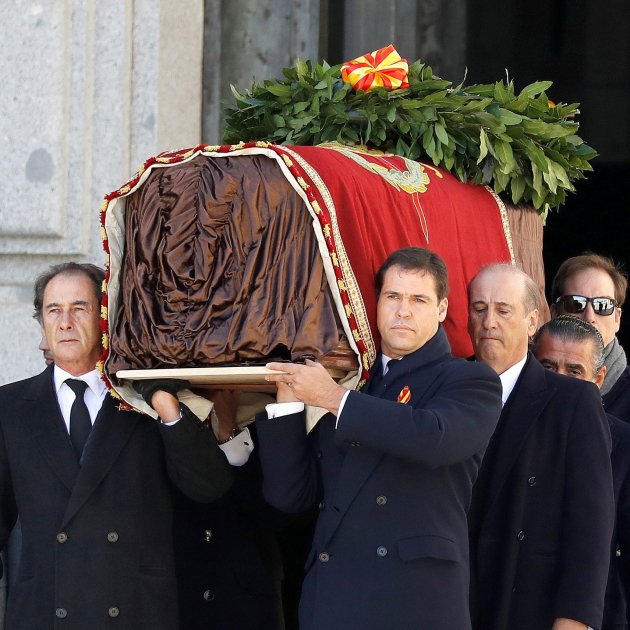Just shy of 44 years since he famously died in his bed, Spanish dictator Francisco Franco has finally been removed from his highly controversial resting place in the basilica in the monumental Valle de los Caídos (literally, "Valley of the Fallen"). It was the first great promise of Pedro Sánchez when he became prime minister in June 2018; over a year later he's finally achieved it. Another promise would be that it would be done with the maximum possible discretion: in that he was possibly less successful. Some 500 professionals from 150 media outlets were accredited to cover the exhumation, more than a third of them from abroad. Spain's public broadcaster offered a free, live, uninterrupted signal to the whole world as he was moved from the Valle to Mingorrubio cemetry in El Pardo, near Madrid. Spain was trying to finally clean out and properly heal one of its many wounds, and did so in a show on a grand scale with hints of the surreal and the grotesque. At times it seemed almost like a state funeral.
Read Nicolas Tomás's report on the history and current meaning of the Valle de los Caídos.
Green = Valle de los Caídos; Red = Mingorrubio cemetery
Officials started arriving at the Valle de los Caídos shortly after 9am, led by justice minister Dolores Delgado acting as Spain's senior notary public. The 22 relatives of Franco who attended arrived in three minibuses. One car played El novio de la muerte at full blast (a song closely associated with the Spanish Legion whose title literally means "the groom of death"). At the same time, a dozen wreaths were arriving at Mingorrubio from all over Spain, all bearing the Spanish flag: "Valencia with the Generalísimo," read one, "Barcelona with Franco always," another. Some of the workers carrying them were dressed in Spanish infantry t-shirts. Later arrived priest Ramón Tejero, ready to say mass for the dictator in the cemetery alongside prior Cantera, the abbot of the Valle de los Caídos. Tejero is the son of former Civil Guard lieutenant colonel Antonio Tejero, the visible face of an attempted coup d'état against Spain's new democracy in 1981.
The pro-Franco demonstrators, over a hundred in total, who wanted to go up to the cemetery were kept some 300 metres (1000ft) away by the National Police Corps. There they stayed with their Spanish flags (both current and Franco-era), their flags of Franco's Falange party and their chants of "Franco, Franco", "Sánchez traitor" and "Arriba España", a Francoist slogan meaning "arise Spain". Meanwhile, one surprise showed up: Antonio Tejero, the coup leader himself. He had wanted to try and go into the cemetery, but police ended up inviting him to leave.
With airspace already shut, at four minutes to eleven in the morning, the exhumation officially began in the basilica. The 1,500 kg (240 st) stone over the grave was lifted at 11:44 "without incidents". Workmen then prepared to remove the casket from the ground. The original coffin from 1975 showed signs of damage, but the family decided it shouldn't be changed. At 12:36, prior Cantera blessed the casket, a request from the family accepted by the government. At 12:48, grandchildren of the dictator shouldered his remains and started walking from the altar to the esplanade. Six minutes later, they exited the basilica, giving the world its first view of the coffin in over four decades. No formal state honours were allowed: there was no flag, only a Laureate Cross of Saint Ferdinand. After they'd put his body in the car, his relatives shouted a "Viva Franco".
That wasn't even the first controversial moment: the dictator's grandson Francis Franco had arrived with a "pre-constitutional" flag. He wasn't allowed to take it into the basilica. "Officials placed it in one of the cars which was transporting the family," government sources say.
The dictator was taken away from the monument in a Super Puma helicopter of the Spanish Air Force at 1:40pm. The transfer took about ten minutes. His destination isn't free from symbolism either: Mingorrubio cemetery, close to El Pardo Palace, was the dictator's former official residence and is now where foreign heads of state stay when visiting Spain. Franco's wife is there, as are many senior officials of his regime, and even another dictator, Rafael Leónidas Trujillo from the Dominican Republic. The helicopter landed on the nearby firing range of the Royal Guard, where the coffin was collected by another funeral car. It arrived at the family's mausoleum at 2:40.
Within the cemetery, it was even more intimate, for the family alone. They celebrated mass for Franco, said by the prior of the Valle and Tejero's son. Unlike in the basilica, the Spanish government couldn't place any restrictions on symbols in the family vault.
